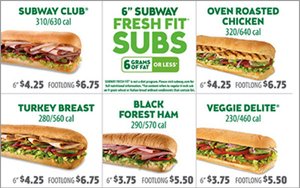restaurants
FDA Releases Final Menu Labeling Rules, After Six Years
- by Karlene Lukovitz @KLmarketdaily, May 2, 2016
 Six years after calorie labeling on menus was mandated as part of the Affordable Care Act of 2010, the Food and Drug Administration has released
final guidance on implementing the regulation.
Six years after calorie labeling on menus was mandated as part of the Affordable Care Act of 2010, the Food and Drug Administration has released
final guidance on implementing the regulation.
Compliance and enforcement will kick in a year from now, in early May 2017.
The requirements apply to chain restaurants, supermarkets and other foodservice venues with 20 or more locations.
The National Restaurant Association stopped opposing menu labeling in 2009. McDonald’s set a high-profile precedent by posting calorie counts on U.S. menu boards in 2012; Panera Bread was among those that followed. Subway (shown) said it did the same as of last month.
advertisement
advertisement
But pizza chains and some other restaurant chains – along with grocery and convenience store retailers – have maintained that application of the FDA’s guidelines in their businesses would be burdensome, expensive and confusing for retailers and consumers.
Most recently, they backed the Common Sense Nutrition Disclosure Act of 2015, which would allow posting calories on Web sites instead of in-store menu boards, among other changes to the FDA draft guidance that was released last September. The Disclosure Act was passed in the House in February, and backers are still pushing for its passage in the Senate.
The Center for Science in the Public Interest, which began advocating calorie disclosure on menus in 2003, said in a statement that it believes the bill is unlikely to advance in the Senate. It also noted that since 2006, when New York City overcame a court challenge by the restaurant industry to become the first jurisdiction to require calorie counts on chain menus, California, Seattle and about 20 other jurisdictions have passed similar legislation.
Food Marketing Institute president and CEO Leslie Sarasin says that the final guidance fails to provide the supermarket industry with enough flexibility for practical implementation of labeling in stores. “The supermarket industry still seeks flexibility from FDA,” she said in a statement.
The FDA said that it’s “committed to working flexibly and cooperatively with establishments covered by the menu labeling final rule and to providing educational and technical assistance for state, local, and tribal regulatory partners to support consistent compliance nationwide.”




